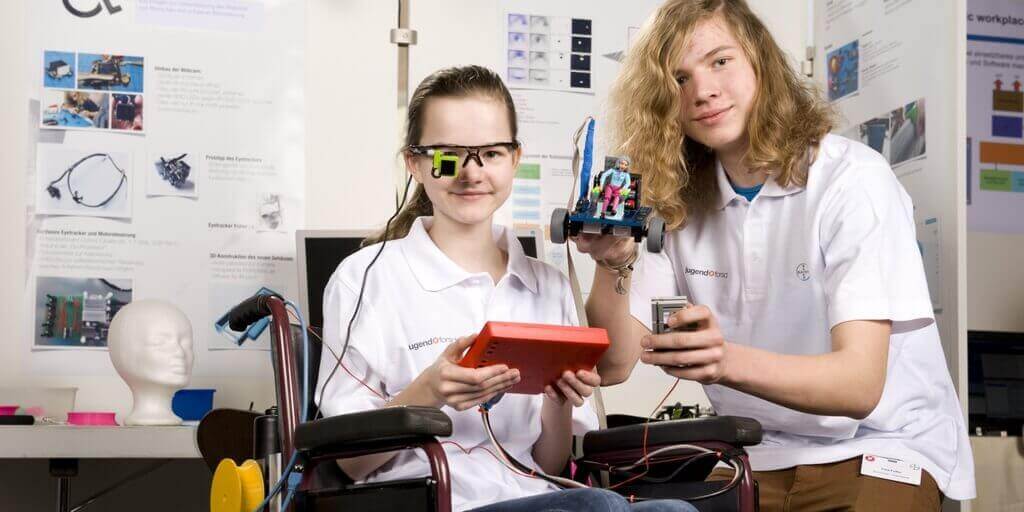Using a Raspberry Pi and 3D printing, a pair of German teenagers have developed a low-cost, eye-controlled wheelchair. And it’s open source.
“I like swimming and climbing, and I LOVE playing the drums, soldering, programming and Aikido” — this reads like the typical blog entry of a 14-year-old girl.
But Myrijam Stoetzer, who attends Franz-Haniel-Gymnasium in Homberg, Germany, differs from most teenagers. Ever since she attended a robot class in 3rd grade, she’s been interested in science projects.
For the past several years, Stoetzer has won several prizes in Germany’s Jugend Forscht, a prestigious competition to promote the work of young designers and engineers.
For 2015, she teamed up with her schoolmate Paul Foltin, aged 15, who also regularly competes in Jugend Forscht. Their teamwork resulted in a first prize in June for an eye-controlled wheelchair.
Eye-Controlled Wheelchair with 3D Printing, a web-cam and Raspberry Pi

What’s so interesting is the low-cost approach they took. People with complex medical conditions rely on power chairs. These high-tech, high-cost wheelchairs are usually manipulated with a control joystick located at the hand rests. A regular power chair costs $10.000 dollars and more.
But some people — most famous being Nobel Price winner Steven Hawking — lack the ability to use their hands. Instead, they operate the chair through twitches of their facial muscles.
This is a difficult and time-consuming task, as the control system requires a lot of customization and calibration. Chair, camera, and software have to be precisely customized. That makes the chairs expensive — a huge problem for disabled people, where insurance might not cover the cost.
“We wanted our project to be as cheap as possible to be affordable for everyone. Our aim is that this approach can be used widely and rebuild for people in need,” Stoetzer explains on her blog.
“Our aim is to provide additional assistance to people with severe illnesses like ALS or MS that lead to persons not being able to move anymore close to a lock-in-state, where an active and alive mind is locked inside a body with extremely limited communication possibilities left – eye movements. Our inspiration are people like the famous physician Stephen Hawking, who now uses a computer speech syntheses that is controlled by a small muscle movement in his cheek or TEMPT, a graffiti artist who was locked inside his body for 7 (seven!) years before friends build him an eye-tracker that allows him to paint again – virtually, using his eyes.”
Best Part: They Made it Open Source

The teens used recycled parts (i.e. motors from wind-shield wipers), a regular web-cam, and 3D printed tools for their surprisingly inexpensive project.
The centrepiece is an ordinary pair of safety glasses. Mounted on it is web-cam with a 3D printed case with a set of infra-red LEDs. The LEDs, which also work in low-light conditions, illuminate the eye; the web-cam picks up movement, which allows the user to operate the chair by just moving his eyes.
The “brain” of the system is the low-cost computer Raspberry Pi 2B, which controls the motors.
Myrijam Stoetzer and Paul Foltin decided to use a motorized manual chair rather than a costly and heavy power-chair. To avoid accidental movements, the system even comes with a safeguard.
Foltin and Stoetzer have made their entire project open-source. So everyone can build, use and improve it.
You can find the detailed documentation on Stoetzers’ blog. So the code and related materials can end up where they’re most needed; in developing countries, where mobility needs are often high but few resources are available to disabled people.
What‘s next for the two winners? They may start another project with their brothers afterwards — Paul’s 11-year-old-brother Theo is working on making longboards safer. And Myrijam’s brother is planning to launch a rocket made from old bottles, garden equipment, and electronics.
Oh, and next week, they’ve been invited to meet German Chancellor Dr. Angela Merkel. The force is strong with these kids.
License: The text of "German Teens Build a Low-Cost Eye-Controlled Wheelchair" by All3DP is licensed under a Creative Commons Attribution 4.0 International License.